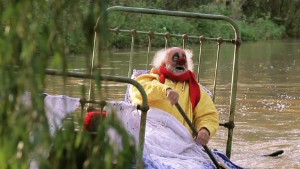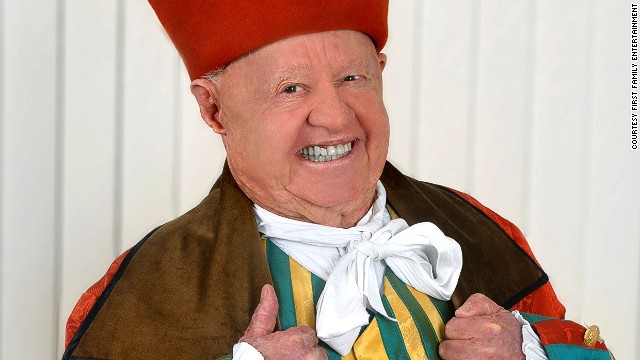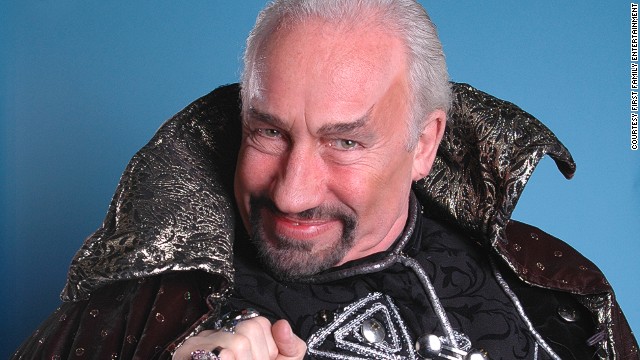- Cross-dressing, audience participation, dance routines. It's got to be "panto"
- Unique British Christmas tradition sees classic fairy tales brought to life onstage
- International stars are getting involved, including Henry Winkler and David Hasselhoff
- Queen Elizabeth II dressed as a prince, in palace production during teenage years
London (CNN) -- Something strange is going on in Britain. Some of the biggest TV stars of the 20th century are donning luscious wigs and scaring the wits out of children.
And Queen Elizabeth isn't in a position to stop them either -- she's guilty of joining in herself.
Overweight men are squeezing themselves into dresses, young women are prancing about on stage incessantly slapping their own thighs, and everywhere families are wildly screaming "He's behind you!"
It doesn't make any sense. But then, that's pantomime -- or "panto" as the British fondly refer to it -- a musical comedy unleashed across theaters every Christmas season and like nothing you've ever seen before.

Imagine your favorite childhood fairy tale -- "Peter Pan," "Cinderella," or "Robin Hood." Now subvert it with cross-dressing, topical references, audience participation, big song and dance routines, and you've pretty much got the idea.
Small stage, big names
But wait. What's this? Recently panto has been getting a celebrity makeover. Once the realm of local actors, now international stars are getting involved.
Henry Winkler, better known as "The Fonz," from TV show "Happy Days," and David Hasselhoff, better known as, er, "The Hoff," are wearing Renaissance wigs, badly drawn mustaches, and 45 kilograms of embroidered velvet as they bring to life one of the most infamous panto characters of all -- Hook.
"For me, there's no other part," said 68-year-old Winkler, who has been playing the Peter Pan villain since 2006, resurrecting him again at London's Richmond Theater this year.
"All of a sudden you just hear the tiniest voice on the planet either yelling 'Booooo' or 'Peter! He's behind yoooouuu.' Then when Peter is banishing me from Neverland you hear this voice go 'Yay!' and I turn to where it's coming from and say 'Well, I didn't like you much either.' It's just great."
Read this: Step inside master clown's fairy tale home
 A pantomime dame with a twist
A pantomime dame with a twist
 Meet the world's greatest clown
Meet the world's greatest clown
 Creating magic with physical theater
Creating magic with physical theater
And it's true, one of the great joys of panto is seeing the audience erupt with lines that have been passed down through generations; youngsters standing on their seats to yell "Oh yes he is!" while parents laugh at the sexual innuendo flying just above their heads.
"It's not the kind of theater-going experience where you have to sit still and shut up and feel that you have to be very educated to understand," said professor Katherine Newey, chair in theater history at the University of Exeter.
"I think one of the joys of seeing it with children is that you've got an excuse to be a child again."
English eccentricity
Not even Queen Elizabeth is immune to the magic of panto, with a treasure trove of old photos recently revealing she wore her own curly wig when she played the male lead of Prince Florizel in a palace production of "Cinderella" in 1941.
Swimming in lace ruffles and silk knickerbockers, the then-15-year-old Elizabeth starred opposite her 11-year-old sister Margaret -- who took the title role.
"It's the one opportunity for us to let our hair down," said Newey. "It seems like this weird, eccentrically British thing -- so of course we keep doing it because part of our national self-image is taking delight in being a bit odd and eccentric.
"Yes, the pantomime dame is a man dressed as a woman. Yes, the princip boy, the hero, that's a woman dressed up in tights and knee-high boots, slapping her thigh. Obviously."
Happy Days
And then there's the larger-than-life villain. Enter The Fonz.

"Everyone who is 35-and-up recognizes me from 'Happy Days,' said Winkler, today a grandfather-of-three.
"And they can call me The Fonz all they want because they have also gone with me on my journey -- I've never been restricted in my career by it," adds the man who tells me that over his career he's produced 19 years of TV series if you watched them back-to-back, and in 2011 received an Order of the British Empire for his work with dyslexic children after also suffering from the condition.
Read this: 342 takes for one movie scene
The native New Yorker admits he never heard of panto before getting involved. But now he's, ahem, hooked.
"It's the story of Peter Pan with Vaudeville in the middle -- it's like chocolate candy with this delicious melted syrup in the center," said Winkler.
Henry Winkler
"As Hook, I'm wearing about 100 pounds of velvet, I'm wearing a King James wig with curls down to my shoulders, I'm wearing a hat. If you don't make that animated, you will get swallowed up and then I would just be lost. So the movement is very calculated. It's a very important part of bringing the character to life."
Rich tradition
Today, panto is seen as a uniquely Christmas tradition, but it wasn't always the case.
"Pantomime as we know it now really emerges in the second half of the 19th century," said Newey.
"The original pantomimes had an opening scene, generally a fairy tale, with characters which wore these big masks and were often quite satirical of contemporary politics or events."
When Victorian writer Charles Dickens began writing about Christmas and pantomime, the two became cemented in the national psyche, with panto even spreading to other Commonwealth nations. And with many Britons having Boxing Day -- December 26 -- off work, it became an ideal time of year to enjoy the show.
With The Fonz and The Hoff now tackling panto, does that finally make it cool?
"I never knew it wasn't," says Winkler.
 Pantomime is a British Christmas tradition that sees classic fairy tales brought to life onstage. In recent years, international TV and movie stars have been gracing the panto stage. Pictured, Henry Winkler makes his debut as Hook at New Wimbledon Theatre (2006).
Pantomime is a British Christmas tradition that sees classic fairy tales brought to life onstage. In recent years, international TV and movie stars have been gracing the panto stage. Pictured, Henry Winkler makes his debut as Hook at New Wimbledon Theatre (2006).
 Princess Margaret (L) and Princess Elizabeth (R) on stage in a pantomime of "Cinderella" at Windsor Castle in 1941.
Princess Margaret (L) and Princess Elizabeth (R) on stage in a pantomime of "Cinderella" at Windsor Castle in 1941.
 David Hasselhoff debuts in pantomime as Captain Hook in "Peter Pan" at the New Wimbledon Theatre (2010).
David Hasselhoff debuts in pantomime as Captain Hook in "Peter Pan" at the New Wimbledon Theatre (2010).
 Dirk Benedict (who played Lieutenant Templeton "Faceman" Peck in The "A-Team" television series) as King Rat in "Dick Whittington," in Milton Keynes (2010).
Dirk Benedict (who played Lieutenant Templeton "Faceman" Peck in The "A-Team" television series) as King Rat in "Dick Whittington," in Milton Keynes (2010).
 Steve Guttenberg ("Three Men and A Baby" and four "Police Academy" films) as Baron Hardup in "Cinderella" at the Churchill Theatre, Bromley (2008). Guttenberg apparently turned down two movie offers to play Baron Hardup -- taking the advice of his good friend Henry Winkler.
Steve Guttenberg ("Three Men and A Baby" and four "Police Academy" films) as Baron Hardup in "Cinderella" at the Churchill Theatre, Bromley (2008). Guttenberg apparently turned down two movie offers to play Baron Hardup -- taking the advice of his good friend Henry Winkler.
 Hollywood royalty Mickey Rooney makes his debut as Baron Hardup in "Cinderella" at Sunderland Empire (2007).
Hollywood royalty Mickey Rooney makes his debut as Baron Hardup in "Cinderella" at Sunderland Empire (2007).
 Patrick Duffy (best known for his role on Dallas, where he played Bobby Ewing) makes his debut as Baron Hardup in "Cinderella," at New Victoria Theatre in Woking, Surrey (2006).
Patrick Duffy (best known for his role on Dallas, where he played Bobby Ewing) makes his debut as Baron Hardup in "Cinderella," at New Victoria Theatre in Woking, Surrey (2006).
 Another Hook -- Paul Michael Glaser at The Churchill, Bromley (2007). Glaser is best known for playing Starsky in 1970s television show "Starsky and Hutch."
Another Hook -- Paul Michael Glaser at The Churchill, Bromley (2007). Glaser is best known for playing Starsky in 1970s television show "Starsky and Hutch."
 Priscilla Presley makes her pantomime debut at the New Wimbledon theater, London. (2012). She returns to the pantomime stage this year to play the Wicked Queen in "Snow White and the Seven Dwarfs" opposite "Willow" actor Warwick Davis.
Priscilla Presley makes her pantomime debut at the New Wimbledon theater, London. (2012). She returns to the pantomime stage this year to play the Wicked Queen in "Snow White and the Seven Dwarfs" opposite "Willow" actor Warwick Davis.
 Simon Callow (most often seen performing Shakespeare but perhaps best remembered worldwide for his roles in "Four Weddings and a Funeral," "A Room with a View" and "Shakespeare in Love") as Abanazar in "Aladdin" at the Richmond Theatre, Surrey (2005).
Simon Callow (most often seen performing Shakespeare but perhaps best remembered worldwide for his roles in "Four Weddings and a Funeral," "A Room with a View" and "Shakespeare in Love") as Abanazar in "Aladdin" at the Richmond Theatre, Surrey (2005).
 Winkler dons the hook and curly wig once again this year at the Richmond Theatre (2013).
Winkler dons the hook and curly wig once again this year at the Richmond Theatre (2013).